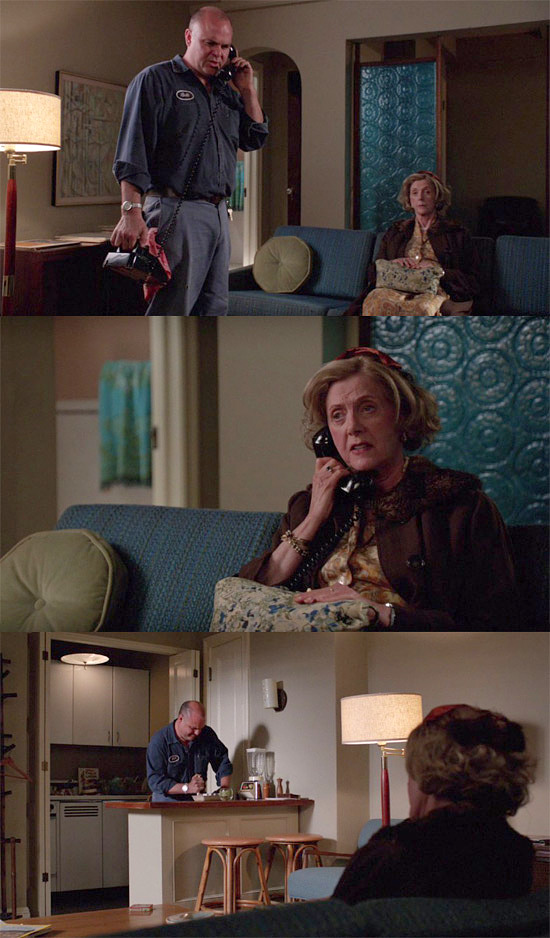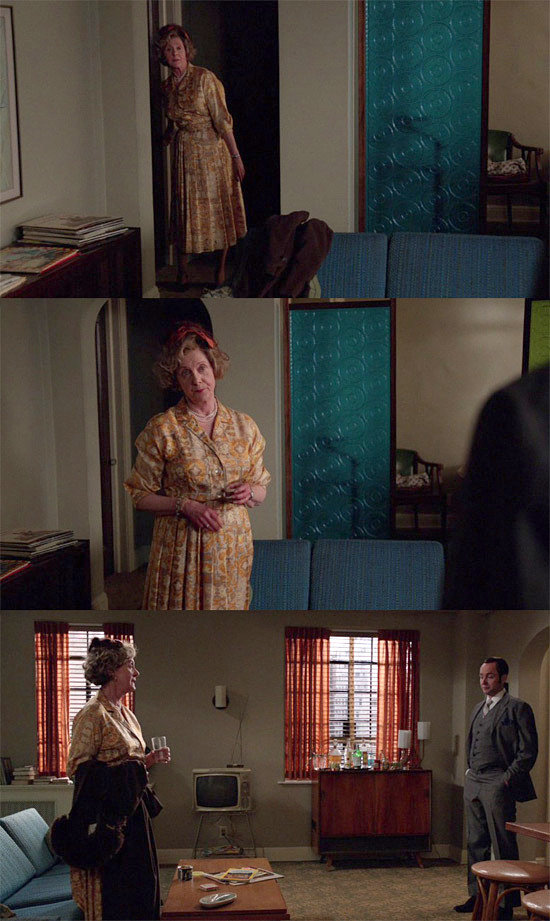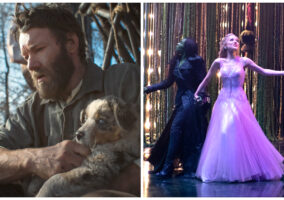At least once a Mad Men season, we have a brief, mad, completely self-absorbed moment when we entertain the notion that costume designer Janie Bryant is deliberately fucking with the two of us. It passes after a time, but make no mistake, the color story we’ve been documenting all season got seriously upended this week, forcing us once again to question what certain things mean.
We keep shorthanding “blue and green” in our writeups, but not everyone follows this recap from week to week, so …
Previously on Mad Men… the blue-and-green color combination has featured quite heavily and consistently in every episode this season, from Peggy dealing with a difficult client situation, to Megan and Sylvia awkwardly bonding, to Pete’s apartment, which is a monument dedicated to cheating, both on wives and on clients, to Ted and Peggy talking about Heinz to Ted and Peggy kissing, to framing a cuckolded man with a couple of adulterers, to Harry and Scarlett, who seem to have an interestingly close relationship, to Joan confronting Dawn, to Trudy throwing Pete out.
There have been other persistent motifs, like the “women in black” one that hearkens to all the assassinations this year, and the “woman in red” one, which triggers Don’s prostitution issues. We’ve had some fun this season trying to parse meaning out of the B&G motif, offering up water imagery (hearkening back to the suicidal Hawaii ad), motherhood, and adultery as possibilities. We thought we’d settled on that last one, but not only did the combo come back in a very precise way this week that somewhat upended our notions on its meaning (once again), Janie introduced a new color combination that was so persistent and meticulously applied, that we might have had a slight OCD-triggered breakdown trying to take it all in and figure out a meaning behind it.
Forget the blue-and-green discussion for a moment. We all need to sit down and figure out…

Just what the hell this whole new “blue and YELLOW” thing is all about.

Because it was persistent as hell.

No, really. By the end of the episode, our eyelids were twitching.

And you wanna talk about subtle? This motif was so masterfully applied that it took us several viewings – where we were specifically looking for it, mind you – to realize just how pervasive it was.

For instance, it took three viewings to determine that everyone in this conference room is wearing something blue or yellow.

And so is everyone in the creative department.

Are you seeing it yet?

Because there comes a point where a motif occurs so often and is applied so consistently that anyone attempting to provide a critical analysis would sound silly trying to be timid about it.

At first, we thought blue represented Don and yellow represented Ted, which makes a certain amount of sense, because not only do they both wear their respective colors frequently, but the story dealt with the upheaval of the decision these two made last week. A coming-together, complete with the expected difficulties, represented in color. Two men in a dick-measuring contest that’s involving dozens of other people.
But let’s step away from that color combination just for a second.

Because you could look at another motif this episode, which was “women in blue,” something that Janie’s played around with just recently, in “The Flood.” In this scene, Peggy’s doppelganger Marge is dressed similarly to her, in a frumpier, darker version of her own suit.
As a sidenote: it’s so odd to see Ginsberg and Stan in outfits that match that exactly, which is why we think Janie was being more deliberate than usual this week with her color choices.

And it would be impossible to view this scene without taking in how different each character is while at the same time noting their similarities. Peggy and Joan have very different ways of navigating the world and their clothes reflect that, but the blues also reflect two women who sought power in the patriarchy and two women who had unexpected pregnancies radically alter the directions of their lives.
What’s great about both of these looks is that they’re both wearing meant-to-impress business suits, but the effect is radically different on each of them. They’re feeling their power but expressing it in ways distinctly their own. And you absolutely have to refer back to the scene it’s mimicking just to see how far these two characters have come in how they express their worth:

A lot can happen in eight years. One of the great things about Janie Bryant as a costume designer is how well she understands the characters and how well she understands the relationships people have with their clothes. Peggy got her promotion to Junior Copywriter in the above scene.

Eight years later, with so much more power and experience, she still dresses in Peter Pan collars with detailing like large buttons. Her style has changed, but she remains the same person. And it’s notable how little we’ve seen her in her former schoolgirl plaids this season. Similarly, Joan doesn’t dress in that va-va-voom manner anymore, but just because of the reality of her body, she still wears very form-fitting clothing, even as she’s mimicking menswear to reflect her stance as a partner.
But we think the “woman in blue” theme really came down to two women; the two who are most central to Don’s life at the moment.

This is, without a doubt, the most declarative, assertive thing Peggy ever wore on the show. If you’ve been paying a lot of attention to her style over the years, it’s a jaw-dropping look. Everything about it is new for Peggy; gone are the Peter Pan collars, to be replaced by these enormous lapels; gone are the schoolgirl plaids, to be replaced by the loud, modern, totally ’68 print in the skirt. Gone is the timidity and any schoolgirl or secretarial references. With the straps-and-buckles and the emphasis on the shoulders, this suit speaks of power. And power is what she’s wielding here. She’s always had some free rein to speak freely to Don, but she’s never thrown her weight around like this, ambushing him in his office and telling him how it’s gonna be from now on. She’s not the girl he gets to yell at anymore.
Just remember: the last time these two were in a room together and one of them told the other to “Move forward,” it was when Peggy was in the Psych Ward. MASSIVE change in the dynamic.
Peggy’s look here is calling to Megan’s from later in the episode:

But the similarities are ironic. Peggy’s blue and white suit is all about power and assertiveness and discipline. Megan’s blue and white peasant blouse is about not having restrictions, but it’s also, in the context of the scene and in response to Peggy’s outfit, about being obsequious. She’s being the good wife, trying to take time off from her own job so they can spend more time together. Trying to go back to Hawaii (which is paradise) in an attempt to save her marriage. So deferential to him that he can tune her out completely; something that’s fairly impossible to do with Peggy.
Joan’s blue suit went off and had an adventure of its own this week, but let’s put that aside for now.

So what’s the deal with all the yellow? Is it a margarine thing? Yes and no. We’re thinking the endless talk of margarine (including the mention of the word yellow) may have triggered this motif, but like the blue one, we think it comes down to two women, and all the other instances of yellow are calling back to them. And unlike the blue motif, which dealt with the power women hold (or the lack of it), the yellow motif dealt with women trapped; in each case, literally trapped inside a room.

Sylvia willingly let herself be held hostage to Don’s demons and submitted to him because she didn’t want to feel anything. With her husband leaving and her son stuck in Paris during the riots, she sought out a trap and backed herself into it, pretending not to know what she was doing.

Dorothy, on the other hand, is trapped against her will, in a scene that is deliberately staged and shot to look like a perverse, twisted version of Don’s hotel room tryst. Don kept Sylvia trapped there partially because she wanted to be and partially because he laid bare his own wants, without any niceties. He ordered her to stay and she stayed. Pete kept his mother trapped there by lying to her and plying her with alcohol. Yet another way in which Pete’s life mimicks Don in the worst, seediest ways possible.

It also should be noted just how out of style Sylvia is. She always has been, but it really ramped up this episode. Not only is this a dress more 1958-stylish than 1968-stylish, it also has some subtle signifiers that read stereotypically “Italian,” like the floral, the peasant neckline, and the once-again prominent cross. Similarly, Rachel Menken, who is the Don mistress most like Sylvia, was dressed in subtle signifiers that read as Manhattan Jewish, like the prominent jewelry, lacquered hair, exotic hats, and cigarette holder. The point isn’t that this is how Jewish and Italian women dress so much as it’s how Don sees each woman; as a fetish figure. My Jewish Mistress. My Italian Mistress.

Similarly, when he dresses her up for sexual fantasies, everything about her is a decade out of style, from her Betty Rubble hair, right down to her underwear. It’s interesting that when he had the perfect 1950s wife; he cheated on her with a succession of very modern 1960s women, from Midge to Bobbie Barrett, to Rachel to Suzanne. Now that he’s married to a very modern 1960s wife, he takes on a 1950s mistress. Face it: he’s chronically unsatisfied.
And yes, we did a little fist pump and a “DAMN, WE’RE GOOD” on the couch when she opened up that box and took out that red dress. As we’ve noted all season, a woman in red signals Don’s obsession with prostitution and the fact that he tends to see all women as whores in one way or another:


But unlike the other two women trapped in a room (because yes, there’s a third), Sylvia managed to walk out of hers on her own two feet. Significantly, she didn’t walk out and leave Don behind. She took him with her. This wasn’t an escape from a jail; it was an ending of one; a jail entirely of her own devising. Don never held the power here at all.

Our final trapped woman of the week is Joan. Bob told her she couldn’t stay in this room and she told him tearfully that she couldn’t leave it, which resulted in her literally leaning on him in order to get out. Dorothy: trapped by lies and dementia, not able to escape. Sylvia: trapped by her own ennui and anxiety, leaves on her own. Joan: trapped by pain and embarrassment, escapes with the help of a White Knight.
Joan’s suit of power reads entirely different once she puts on that brilliant green trench. It’s no longer about power, but because we’re back in the land of the much-discussed blue-and-green color combo, it’s not quite as clear what this is all about.

It’s notable that the other trapped women wore yellow and were at the mercy of asshole men. In Joan’s case she’s at the mercy of a man acting kindly toward her and – in a total reversal – he’s the one in yellow.
It’s significant that this scene hearkens back to the emergency room scene in season 3 when Don and Joan shared a laugh over poor Guy MacKendrick’s misfortune. Why is it significant?

Because it’s followed by this scene, which very closely mimics the scene when Don tried to talk her out of prostituting herself. In fact, in many ways, it’s a total reversal of that scene. A man (who looks like Don and has a similarly alliterative 3-syllable name) from her office comes to her home while she’s in a bathrobe. Except this time, instead of coming to talk her out of something sleazy, he’s coming to give her a gift and express his concern for her. Regardless of whether Bob is a shit who’s just looking out for himself, he’s still someone who showed kindness and concern for Joan – and that’s in seriously short supply around that office.
Joan has a long history with floral and botanical prints (mostly roses) that represent the state of romance in her life. We picked up immediately on that print, as well as the fact that the blue-and-green color combo is all over this scene as well.

But when we got to this eye-popping look, we threw up our hands in despair, you guys. It clearly means something that Joan is ONLY in blue and green this episode and that her story was so different from the other women’s. Potential romance was written all over the Bob Benson scenes, even if we find the prospect a little unlikely for Joan, who should have had her fill with office romance by now. Still, we can’t quite claim it means “adultery” anymore, even though it’s been fairly consistently applied to scenes revolving around cheating in some way. Sex? Motherhood? Water imagery? Death? The serenity that eludes everyone in this world? It’s all wide open again for interpretation.
One final thing about this look: Joan is wearing gold jewelry far more prominently this season, which signals her increased power and money. Also: this outfit is almost exactly the same as the one she wore when she hugged Dawn, except rendered in different fabrics. Back in the day we noted that Joan had several versions of the same dress in different colors. She’s always known the value of clothes that work for her and never had a problem owning the same outfit in multiple versions.
[Stills: tomandlorenzo.com]
Mad Men: Man With a Plan Next Post:
Doctor Who: The Name of the Doctor
Please review our Community Guidelines before posting a comment. Thank you!



